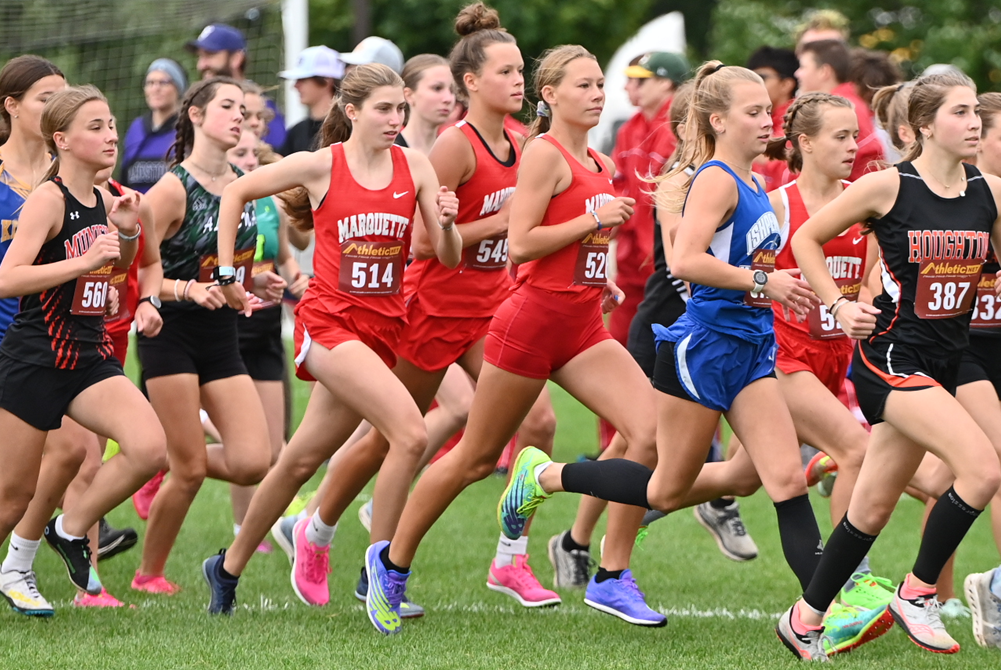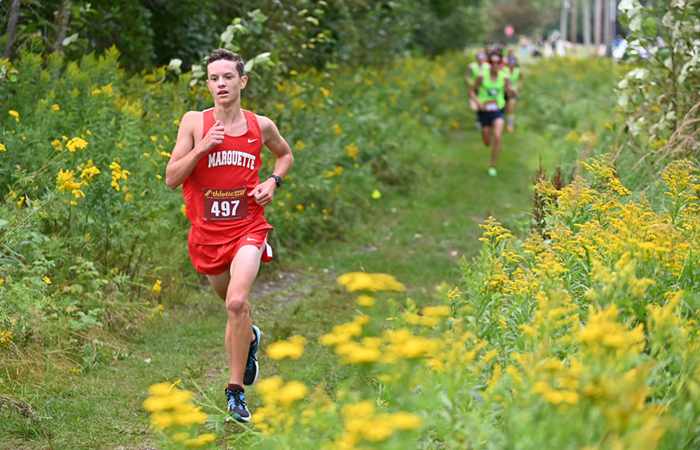
MHSAA Vault: MIS Rose to Challenges to Host 2020 LP Finals
By
Rob Kaminski
MHSAA benchmarks editor
November 12, 2021
The “MHSAA Vault” features stories from past publications and other documents in the MHSAA Library. This issue takes a look at the MHSAA Cross Country Finals at Michigan International Speedway, which celebrated 25 years in 2020 – although it was an event that nearly didn’t happen last fall …
In 1996, the MHSAA and Michigan International Speedway began a partnership the changed the course of the Lower Peninsula Cross Country Finals – quite literally.
The land in and around the track at Brooklyn would host the Finals for all classes of runners in one place on one day, an annual festival of nearly 2,000 runners competing for the MHSAA’s top honors.
Even skeptics – and there were several among running purists who thought the course was too flat, for example – can’t deny the results.
Finals attendance nearly doubled in that first year, and crowds in excess of 10,000 have enjoyed a day of racing several times, including a record 12,153 in 2011.
Enthusiastic crowds were the norm in recent years, with 11,232 in 2017, and nearly 11,000 in 2018 (10,989) and 2019 (10,873).
In fact, attendance failed to reach at least 8,000 only twice since the move to MIS.
Of course, last year was an exception, when attendance was limited to 1,000 spectators per session due to the COVID-19 Pandemic. Fans also were restricted to the grandstands rather than following the action throughout locations on the course.
To reduce the number of runners in each race, the event was spread over two days, with each Division being run in two separate “sections” with times then combined at the end to determine team and individual champions.
While not ideal, the end result was another year of fantastic efforts at MIS – both from student-athletes and those behind the scenes.
“Even at the last hour, less than a week ahead of the Finals, we were closer to not having the Finals than we were to having them,” said MHSAA Assistant Director Cody Inglis, who coordinates the cross country postseason. “Rumors and challenges of mandated shutdowns, testing and other requirements were being discussed and caused a lot of unknowns. Even at the Regional level, we had schools, Regional courses and hosts shutting down their facilities; we had to relocate four Regionals 48 hours prior to race times. That scenario just could not happen at the Finals level where far more runners and much more travel would be involved.”
Among the many last-minute hurdles was the edict from NASCAR – which owns MIS – that all persons on site be temperature checked upon entry. That meant securing thermometers that were easy to operate in short order, along with personnel necessary to conduct the readings.
The attendance limitations certainly helped to implement the temperature screening, but brought their own issues.
“Limiting spectators was not a popular decision, but it really was the only way to have a race,” Inglis said. “We were taking direction and working with policies and protocols from the MDHHS, the Governor’s office, Lenawee County Health Department, MIS and NASCAR.”
Part of the solution was to utilize the grandstands as a “barrier” between participants and spectators. The reduced number of fans were dispersed over thousands of seats while still allowing them the chance to watch their student-athletes compete.
“It wasn’t the same, it wasn’t easy or perfect, but it was what we had to do to have a race,” Inglis said. “Separating the Finals into two days and different sections also allowed us to spread out the event and limit the number of people on site at any one time. This was a key part of the plan and worked well even though it separated races within a Division.”
The MHSAA, MIS and the cross country community never lost focus of the main goal: a culmination of the season for the student-athletes, who deserved something last year more than ever. And, more than ever, MIS once again displayed its advantage as a venue that could adapt to the fluid nature of the times to pull off the event.
“There were some thoughts of using four different sites, but as we learned during the Regionals, the climate of things was so tenuous from one area of the state to another that we couldn’t be 100-percent certain that there wouldn’t again be last-minute cancelations,” Inglis said. “MIS was wonderful to work and collaborate with, and was the best option to get it done. It was never mentioned once publicly about the possibility of not having the Finals – only how we could best do it under uncharted conditions.”
The moving parts and ever-changing scenarios created more complexity than ever in finalizing a season, but every decision was made with the complete desire to conduct the Finals as close to normal as possible.
“I firmly believe that a finish to the season, no matter the differences in race formatting and fan experience, was something everyone would have taken when the season began in August,” Inglis said.
Indeed, the finish line in Year 25 at MIS might have been the most gratifying of them all.

Marquette Carrying Confidence Into Finals After Downstate, Out-of-State Successes
By
John Vrancic
Special for MHSAA.com
October 20, 2023
MARQUETTE — Marquette’s cross country teams are both seeking to continue championship runs at Saturday’s Upper Peninsula Finals at Farmhouse Cross Country Course in Gladstone – the girls for the second-straight season and the boys attempting a fifth-straight title.
 Their travels far and wide this fall have the teams confident that success will continue.
Their travels far and wide this fall have the teams confident that success will continue.
The Marquette girls did something Sept. 15 no other Upper Peninsula team had been able to do, winning the Green division race at the Spartan Invitational at Michigan State University by edging Novi 142-143.
That was the first of multiple successful trips downstate, and Marquette also ran exceptionally closer to home and in Wisconsin against some of that state’s elite.
“I think we’re just really excited,” junior Monet Argeropoulos said. “We’re really looking forward to pushing each other as a team. That’s what keeps us strong. We just need to go down there and take care of business.”
Sophomore Ella Fure was seventh individually at MSU, and senor Abby Harma ran ninth against a field of Lower Peninsula Division 1 schools.
“That’s probably the highlight of the season from a team standpoint,” Fure said during Tuesday’s practice at the Marquette High School track. “We were all crying. At first they announced Novi had won from the unofficial results. We were a little disappointed, although we gave our best effort. Then they found a scoring error and discovered we had won. I think a lot of people were really excited. The car ride home was very good. It kind of flew by.”
After dominating the El Harger Invite at Munising on Sept. 26, Marquette traveled downstate and ran in the Shepherd Bluejay Invitational four days later where the boys placed fifth and the girls were 16th in the Elite division.
 “It’s real different running downstate. We needed to get used to that situation and become more comfortable. I think our athletes know what to expect down there now,” Marquette coach Derek Marr said. “(The girls’) confidence really grew after winning at MSU, and a lot of that carried over into Shepherd.
“It’s real different running downstate. We needed to get used to that situation and become more comfortable. I think our athletes know what to expect down there now,” Marquette coach Derek Marr said. “(The girls’) confidence really grew after winning at MSU, and a lot of that carried over into Shepherd.
“Many coaches believed the U.P. teams couldn’t compete downstate, and that upset me. I think we can compete with anybody if we believe in ourselves. We’ve trying to break that limitation.”
Marquette opened this season with two victories at home, dominating the Queen City Invitational on Aug. 18 and edging Macomb Dakota for the title in the Wildcat Invite on Aug. 26.
“I think that set the tone,” Harma said. “Downstate runners come up here for camps. They’re very fast. It’s easier to run fast with faster people. Winning the Spartan Invitational was very exciting, and three of us going under 20 minutes at Shepherd was a highlight. It has been a long time since a team from Marquette has done that.”
“I would say we had an exceptional season,” added junior Seppi Camilli, who covered the 3.1-mile course at Shepherd in a personal-best 16 minutes, two seconds. “Derek and Paige (assistant coach DuBois) did a great job preparing us. The girls winning by one point at Spartan was definitely the highlight. Competing downstate allowed us to exemplify our depth and talent. I think it makes us execute to show our skills.”
Senior Cullen Papin had similar thoughts about the early-season meets.
“Everybody showed up and really worked hard in our first meet,” Papin said. “In the Wildcat meet it was good to get pushed by the biggest school in the state, and it came down to a sixth-runner tie-breaker. That’s what it’s all about. It shows every runner is important.”
The Marquette boys were runners-up to nationally-ranked Stevens Point, Wis., at Neenah, and the girls placed fourth.
“That was definitely a confidence builder going down to Neenah,” Papin said. “It was exciting to see all the hard work the girls put in really pay off against some of the D-1 powers in the state at Spartan, and all seven of us going under 16:50 at Shepherd was cool. There’s lots of good teams down there.
“The atmosphere in practice is pretty good.”
 John Vrancic has covered high school sports in the Upper Peninsula since joining the Escanaba Daily Press staff in 1985. He is known most prominently across the peninsula for his extensive coverage of cross country and track & field that frequently appears in newspapers from the Wisconsin border to Lake Huron. He received the James Trethewey Award for Distinguished Service in 2015 from the Upper Peninsula Sportswriters and Sportscasters Association.
John Vrancic has covered high school sports in the Upper Peninsula since joining the Escanaba Daily Press staff in 1985. He is known most prominently across the peninsula for his extensive coverage of cross country and track & field that frequently appears in newspapers from the Wisconsin border to Lake Huron. He received the James Trethewey Award for Distinguished Service in 2015 from the Upper Peninsula Sportswriters and Sportscasters Association.
PHOTOS (Top) Marquette's Ella Fure (526), Monet Argeropoulos (514) and Abby Harma (527) make up part of an early pack during the Wildcat Invitational. (Middle) Marquette's Seppi Camilli (497) runs to first place in the boys Wildcat race held on the campus of Northern Michigan University. (Photos by Cara Kamps.)

